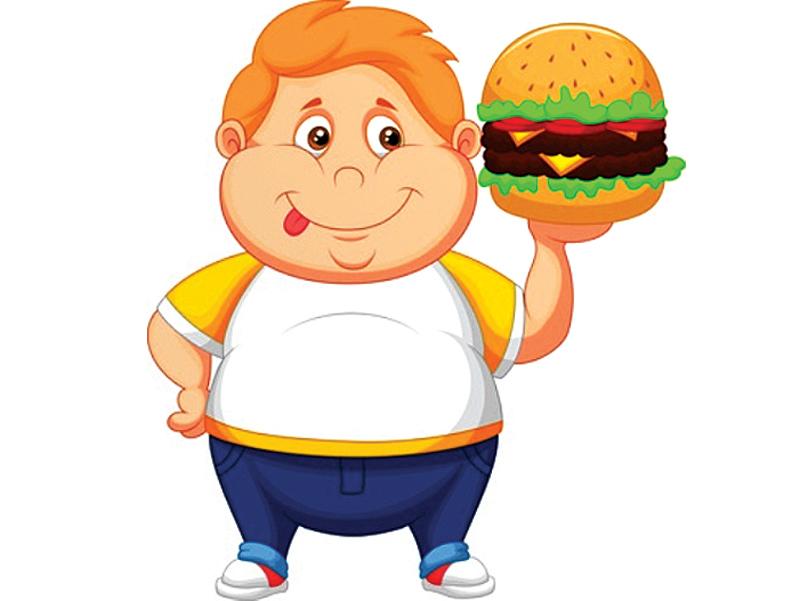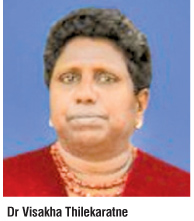
Sri Lanka is in the throes of an Obesity Epidemic. Recent studies have shown a disturbing upward trend in overweight and obese children and adults alike raising serious concerns among health officials it could lead to a further spike in cardiovascular diseases and other non communicable disorders which have gripped this little island.
Obesity (excess body fat) carries many health hazards. Being obese also adversely affects one’s level of nutrition and lowers one’s immunity to combating grave diseases including diabetes, and cardiovascular disorders.
 President Nutrition Society of Sri Lanka and a specialist in obesity, Dr Visakha Thilekaratne expresses her concerns over the rapid increase of obesity, especially, among pre-schoolers and school going children. She blames current food fads such as fast foods and sugary drinks and lack of enough exercise as one of the main culprits and emphasises the urgent need to introduce early intervention starting from infancy, through toddler stage to adolescents to halt the present alarming trend of overweight and obesity in the country.
President Nutrition Society of Sri Lanka and a specialist in obesity, Dr Visakha Thilekaratne expresses her concerns over the rapid increase of obesity, especially, among pre-schoolers and school going children. She blames current food fads such as fast foods and sugary drinks and lack of enough exercise as one of the main culprits and emphasises the urgent need to introduce early intervention starting from infancy, through toddler stage to adolescents to halt the present alarming trend of overweight and obesity in the country.
Excerpts
Q. Not many people know the exact meaning of obesity. Could you explain this term in simple language?
A. Anyone whose weight is 20% or more than the estimated average is said to be obese.
Q. How is it caused?
A. It is the result of a person ingesting more food than he/she needs for producing the necessary energy. These extra calories, wherever they come from - whether carbohydrates, fats, proteins or even alcohol, are ultimately converted into fats and stored in the body.
Q. How is obesity measured?
A. For adults, a simple way of calculating the average weight is using the BMI (Body Mass Index) which records whether a person’s weight is within an acceptable range or whether it is too much or too little.
B MI is calculated by dividing the weight (in kg) by the height (in metres) squared.
Q. Examples?
A. If the weight is 80 kg and the height is 5ft 8 inches, BMI will be 80/1.7= 27.68
Q. What are the health issues that can result from being overweight or obese?
A. Apart from appearance, the extra expense on clothes, the general discomfort, there are many hazards to health such as;
*high risk of diabetes
* High blood pressure (hypertension)
* heart problems
* osteoarthritis
In addition such persons can also be at increased risk to accidents in the home.
Q. Will there be increased complications for obese persons during or after a surgical procedure like heart surgery for example?
A. Yes. They could face greater risk of complications during and after surgery and anaesthesia.
Q. Could an obese person die earlier than a non obese person?
A. Premature death is a possibility.
Q. Are there other factors besides over eating that can lead to obesity?
A. There are some disorders of the endrocrine glands that can cause lethargy and weight increase.e.g. diminished function of the thyroid gland.
But I want to stress here that the large percentage of obesity is not the result of glandular disorders, but rather an imbalance between eating and lack of exercise.
Q. So how does one get rid of this imbalance?
A. With lifestyle changes such as reducing their intake of calorie foods, eating less and exercising more.
Q. Does this rule apply to children as well?
A. Lifestyle changes for children has to be very practical.
This means spending less time on stationary immobile activities and being much more active.
If a child with an average weight is less active he/she can go from go from normal weight to over weight.
In the same way, an active obese child can go from overweight to normal weight according to his height and body frame plus gender. One hour of exercise everyday can make the difference.
Q. You make it sound so easy. Are the parents and school teachers in whose charge children spend at least 5-8 hours aware of this?
A. All schools (government) have growth charts. For a normal weight child to cross into overweight registered on the chart will be because he has spent one hour less on being active in school and vice versa. If an overweight child crosses to the normal weight path, it will be because he/she has spent over one hour in doing physical activity.
Q. What about excessively obese children? Is the time duration for exercise the same?
A. They need to exercise more – at least 1 ½ hours to over 2 hours daily.
Q. Besides exercise, you mentioned food. What kind of food should children avoid eating in excess?
A. To my knowledge, the greatest offenders are highly processed or ultra processed foods. This was proved at last year’s ASEAN Nutrition Company at Tokyo where researchers demonstrated how there is a straight line relationship between the degree of processing of food and increase in overweight.
Q. So what should mothers do to counteract this adverse effect?
A. The thumb rule is to encourage children to eat as much natural food, green leaves, veggies and a lot of fibre legumes like beans, long beans, kohila, dambala and kehelmuwa. Children (anyone under 18 is a child) should have at least 4-5 different food groups in their meals.
The meal should have pulses, protein, one cup of green leaves. At least one cup of fruit – eaten raw in their pristine form is the best way to eat fruit, should also be included in every meal.
Q. What would you describe as a Healthy Plate for children between 2- 18 years?
A. The proportion should be fifty percent of cereal and yams, 33% (1/3 ) veggies and green leaves, 17 % pulses and animal protein and 1 cup fruit eaten raw.
Q. In your studies what can you say about food habits of children today?
A. I see lots of children eating rice or bread with mysore dhall. This is common both in the city and in the village.
The trouble is that they don’t eat vegetables or other cereals. Besides, if you look at the countries from where this dhal is imported, you will see it is not India or Bangladesh or any neighbouring country but faraway places such as Australia, Turkey etc.
Q. Fruit vs obesity- is there a link?
A. The most preferred local fruit children eat today are bananas. But bananas eaten in excess can lead to excess intake of sugar and starch. They should get used to or be encouraged to eat other fruits which are also widely grown and perhaps cheaper.
Q. For example?
A. Gauva, waraka, sapadilla, veralu, nelli, ambarella, mangosteen, rambutan, atha, beli, woodapple, papaw to name a few.
Parents must encourage their children to switch to these fruits by serving these fruits rather than only bananas at every meal.
Q. At what age should parents start influencing their children’s food habits?
A. As early as possible. Unfortunately most parents believe they can change their children’s food habits at a later age when they are adolescents. But this is wrong. Once they get used to eating fast foods, sugary drinks and no fruits, it will be too late to make that switch as they have already got used to eating certain foods and acquired a taste for them.
Q. Junk food?
A. A lot of junk food children even in the villages eat contains MSG (Monosodium Glutomate.) There is a limit that manufacturers can use, and on the plus side most vendors have now kept to this limit under the Food Act. But if food containing even a tiny amount of MSG is ingested in large quantities it can put the child at a health risk.
Q. Drinks?
A. As I said before children consume a lot of sugary drinks, in the form of soft fizzy drinks, ready made drinks, and ice lollies. These drinks as well as oily foods salty sugar based foods are discouraged in school canteens under the School Canteen Policy. But the problem is that many food outlets near the schools offer these foods which are what children like and prefer to buy. We need to find a way of preparing local foods in a more tasty attractive way to cater to the palette of schoolchildren.
Q. What is the best drink for children?
A. Water. They should drink 9-10 glasses of water daily. And two cups of fresh milk. Energy drinks are not necessary if they don’t use a high amount of energy like professional athletes do. Malted milk, chocolate milk, vanilla milk all contains sugar.
Q. Biscuits?
A. Biscuits especially those with chocolate are very popular among young children. This too must be discouraged with parents refraining from bringing them to the house or serving them in their lunch boxes for tea.
Q. Are underweight children also liable to become obese?
A. Research has shown that children who are underweight and had low birth weight tend to stand a higher chance of becoming obese.
Q. Why?
A. Because, to make up for their lack of weight, parents tend to drastically increase their food. Any food increase must be done gradually especially in very young children. A study in 2013 showed that pre-pregnancy obesity was high in the following:
* First born of a particular family
* Rapid weight gain from birth to 2years
* Feeding habits in childhood and infancy
Q. Did the level of education of the mother, her income status and whether she was a working mother or not also count?
A. All these are important factors. Working mothers who switched to complementary weaning foods or artificial milk food early in order to return to work could have increased the risk of obesity.
Q. Your solution?
A. Breastfeeding till over 2 years could offer protection against obesity, besides laying the foundation for a healthy start to life. Raising more awareness on the risks of obesity and need for all obese pregnant women to have themselves screened at our several Well Woman clinics and Healthy Lifestyle Centres must also be encouraged, so that the growth and development of the unborn child is monitored.
Q. Your advice to mothers to prevent obesity in children?
A. Cut out the high calorie, high sugary, high salt food. Make children spend less time in sedentary work and get them to exercise every day.
